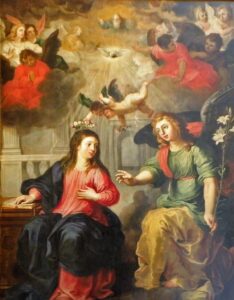Hendrick van Balen: The Annunciation (Mysteries of the Rosary)
‘Annunciation’ could be read today as the ‘trailer’ , to get into the complete storyline.
The Dominican church of St. Paul offers an amazing spectacle. A single theme is depicted by a cycle of no less than 15 Baroque paintings, for which almost as many painters were called upon. The series is based on the devotion to Mary, more specifically, the Rosary.
Prayer beads exist in different religions and cultures, such as the 99 names of Allah; some have even lost their religious background like the Greek bead strings or komboloi (with 23 stones, derived from the religious version with 33 = years of life of Jesus). As a stress-relieving agent they come pretty cheap.
In Christianity, more specifically in Catholicism, the rosary, chapelet or paternoster, contains 5 times 10 beads (plus 1-and-3 extra for introduction), each standing for a series of ten Hail Marys and one prayer of Our Father. The Dominicans attached special importance to this kind of repetitive prayer; you will see that in the large painting by Caravaggio.
Each of these prayer series is associated to a Mystery of the Rosary: during and after her life, Mary experienced five joyful, but also five sorrowful and finally five glorious events. This implies that you should go through the rosary beads three times over to complete the cycle of 15. Those 15 episodes are depicted here along the wall.
The elite of Antwerp painters contributed to this project, which lasted from 1615 to 1620. As such, you get a sample of personal styles and techniques at a glance. Though the paintings are predominantly traditional, occasionally they are very unconventional. Almost all painters were paid comparable fees around 150 guilders but financed by different private sponsors.
Let us have a look at the trailer, the Annunciation; this is the moment when the angel Gabriel tells Mary that she will become a mother. Here it is presented as a day-to-day event in a household. Like in medieval scenes, Mary has a prayer book in her hand, which is an indication of her and other women’s literacy.
The characters are colourful, but similar to ‘play dolls’, they show little emotion (and convey them even less to the spectators).
In his time, painter Hendrick van Balen apparently had a high market value; he was the only one who was paid 216 guilders for his work.
It was in van Balen’s studio, probably located on Lange Nieuwstraat, that the young Anthony Van Dyck started at the age of 10 as an apprentice.
Follow the Mysteries of the Rosary: The Nativity

